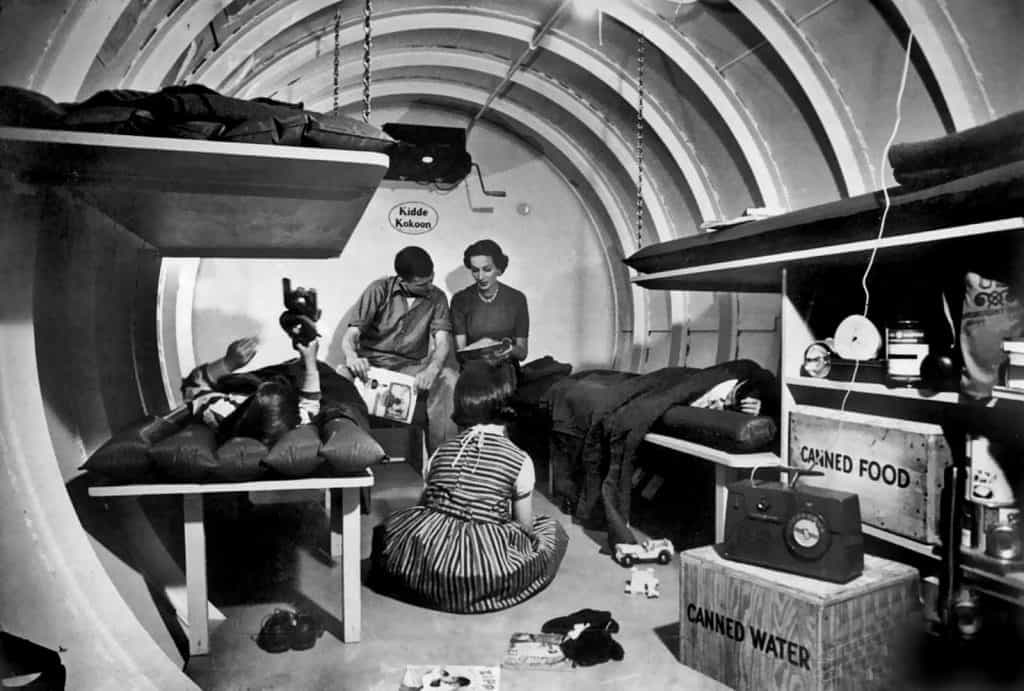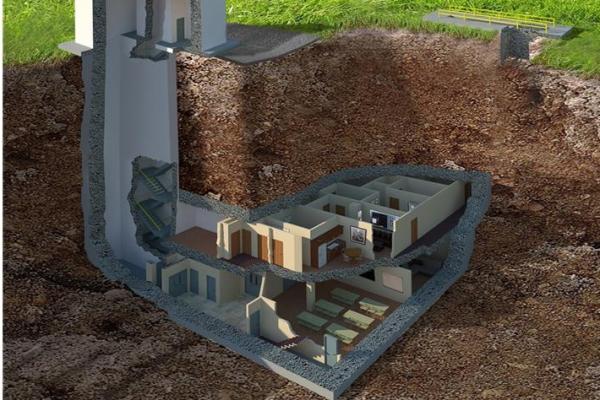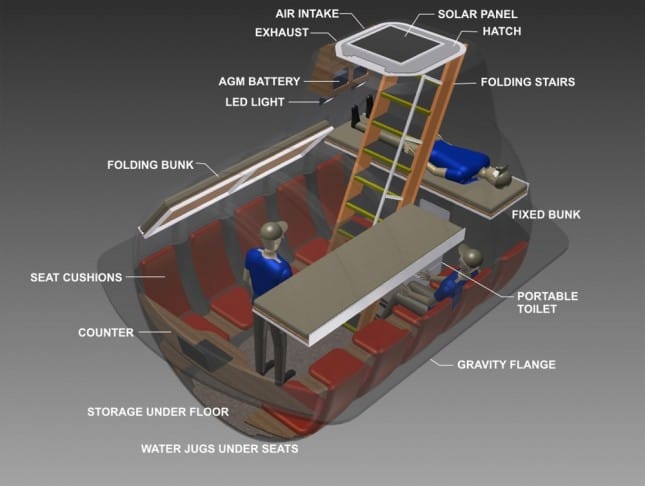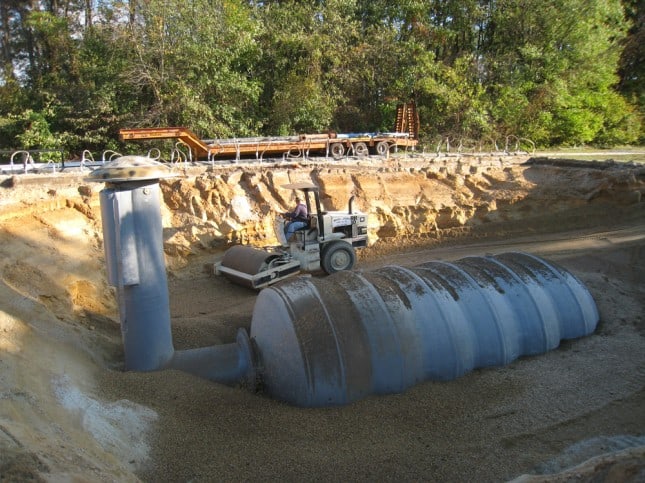How to build a cheap DIY underground bunker to protect you from nuclear fallout, in 6 steps
Interestingly, I rarely see a TOILET in any old fallout shelter photos. How would you like to piss and crap in a bucket and just let it stink up the small space?
How to Build Your Own Cheap DIY Underground Survival Bunker
Many people are waking up to how vulnerable we are to disasters and starting to stockpile survival supplies.
Yes, having a stockpile of food, water, candles, first aid supplies, etc., is vital to get through a short-term disaster like a hurricane or earthquake.
But let’s be realistic. In a significant SHTF disaster scenario, these stockpiles aren’t going to help much: as soon as someone realizes that you have supplies, they will come and take them!
The best way to prepare for disaster situations is to keep your supplies secure in your own underground survival bunker.
Renovating a Fallout Shelter
When people hear “survival shelter” or “underground survival bunker,” it is usually a fallout shelter from the 1950s that comes to mind. So, no wonder people will think you are crazy if you say you are building a bunker. They’ll assume you are prepping for a nuclear war.

Our disaster prep needs are much different today than during the height of the Cold War.
Yes, nuclear war may still be a risk – but the most likely disasters are Electromagnetic Pulse, economic collapse, terrorist attacks, and the chaos that ensues.
So, you don’t need a shelter designed solely to survive nuclear fallout. You need a survival shelter that is capable of hiding you from society!
Unfortunately, most online survival shelter designs are meant for nuclear fallout. They won’t work for long-term sheltering.
For example, a fallout shelter will be sealed off to prevent nuclear fallout from entering. This also means that it will prevent airflow. Those fallout shelter designs are also difficult to conceal and not very comfortable.
Interestingly, I rarely see a TOILET in any old fallout shelter photos. How would you like to piss and crap in a bucket and just let it stink up the small space?
No, a long-term survival shelter needs a sewage drainage system or other emergency toilet system. It also requires a water source if you plan on hunkering down there for a significant amount of time.
If you already have a property with a fallout shelter on it, you can renovate it to make it suitable for today’s disaster prep needs.
Check out this modern underground survival shelter in Georgia set on 20 acres of property. It was made by renovating an old bomb shelter.
You can even buy it… If you have $17,500,000!

Pre-Fab Survival Shelters
Luckily, getting your own hidden underground shelter right in your backyard or on your survival property is easier than ever. Many companies now make pre-fab underground shelters.
You just hire/rent a digger to make a large hole and then drop the shelter into the hole. These pre-fab survival shelters are easy to install, relatively cheap, and offer reasonable protection.
Of course, there are a lot of issues with these pre-fab survival shelters.
First, if you install one in your backyard, your neighbors will see it – which defeats the point of concealing it. Also, you will need to apply for a permit.
High-ranking government officials might look through the permits and then come and raid your bunker. Maybe it isn’t likely, but it is still a possibility. The only way to have a 100% concealed and hidden underground shelter is to build it yourself in privacy.
While having a pre-fab survival shelter is better than not having any shelter, note that these are usually NOT MEANT FOR LONG-TERM SURVIVAL.
They don’t have a sustainable water source (water will run out quickly). Many don’t even have a sewage removal method or chemical toilet installed inside them.
So, be realistic.
This survival shelter will get you through a few months of the disaster, tops. After that, you’ll have to go outdoors and brave the chaos like everyone else (who are remaining at that point).


Building Your Own Hidden Underground Shelter
I know a few people who have built their survival shelters underground and hidden the entrances. Before you start digging, CONSULT WITH AN ENGINEER.
Seriously, consult with someone who knows about design!
Even if the design is good, it might not suit your property type. You’ll need a geological survey, especially if you want your own well.
It is vital to emphasize this, especially since I’ve seen many people talking about “using steel containers as underground shelters in survival forums.”
You can’t just dig a hole and plop a steel container into it! Nor can you dig a hole and construct a concrete room.
There are a lot of issues that need to be considered. Aside from the actual stability of the construction (and its ability to withstand a significant blast), there are issues like ventilation, waste removal, moisture control, etc., which need to be considered.
Here are just some of the things which could go wrong if you don’t plan the survival shelter design right:
- Flooding: You must use drainage systems and ditches to ensure that rainwater and melting snow don’t leak into your shelter.
- Digging through Wires or Pipes: There is a reason you need permits before building an underground shelter. You could dig through the town’s water supply pipes, internet wires, etc.
- Suffocation: Those nuclear fallout bunkers are designed to keep out radiation, but they also will block air. You could end up suffocating. You will need air ducts and an air filtration system.
- Dying of Thirst: You can put a month or two’s worth of water in your survival shelter, but then what? A good design will have a sustainable water source inside. If you are already 30+ feet underground, it isn’t too much more to dig to tap into well water. Then you just need some type of well pump to get that water.
- Sewage Backup: Some underground shelter designs use holding tanks for sewage waste. If a large blast occurs, then the tank can crack. If it is placed close to the shelter, the sewage can back up into the shelter.
- Carbon Monoxide Poisoning: If you plan on using gas for cooking in your underground shelter, you could get poisoned. Leaks could also result in an ignition risk. The best way to cook in a shelter is with an alcohol emergency stove.
Make no mistake: building a secure hidden underground shelter with its own sustainable water source and energy will be pricey.
Do not worry too much if you can’t afford the installation now. Always focus on what you can do for disaster preparation now and improve when you can.
Want Crucial Printable Survival Instructions?
Get our Survival Cheat Sheets.
Instant Download. No Ads.

Are you ready to take control during times of crisis?
A printable guide covering the information you need to know to get you through power outages and other disasters where your best option is staying put.
Leave a comment
So what is the correlated metal tubing typically used for in construction other than fallout shelters? Commercial plumbing or what?
Is resonated fiberglass w steel framing good? Can u reinforce a metal container somehow so it would not cave in? Reply
Sorry I don’t understand your first two questions. Regards reinforcing a shipping container, I see no reason why not if you know what you are doing but remember corrosion will always be a problem so would need to monitor closely for weaknesses in the structure. Reply
I’ve always thought that the large concrete culverts under major highways would work well as a bunker. The ones underneath highway 407 in Ontario, Canada sit deep under the ground, can stand up to large trucks constantly driving over it, and can be made as long as you want. 10’ ceiling, waterproof, a foot thick. All I have to do is win the lottery and I’ll have a big chunk of property to put a huge shelter underground. Reply
Another option is to look around you to find hidden shelters. When I was a scoutmaster, we took a tour of the local sewage treatment plant. I found it unexpectedly fascinating, and was shocked to find that they had a network of deeply buried large concrete tunnels all around the facility. In some types of SHTF scenarios, I would definitely head for those tunnels with their heavy steel doors. Reply
How to build a cheap DIY underground bunker to protect you from nuclear fallout, in 6 steps
Email icon An envelope. It indicates the ability to send an email.
Twitter icon A stylized bird with an open mouth, tweeting.Twitter LinkedIn icon The word “in”.
LinkedIn Fliboard icon A stylized letter F.
Flipboard Facebook Icon The letter F.
Facebook Email icon An envelope. It indicates the ability to send an email.
Email Link icon An image of a chain link. It symobilizes a website link url.
- Fallout shelters can cost millions of dollars. But this DIY underground bunker costs about $1,000.
- You wouldn’t want to live in this makeshift underground bunker forever.
- In a pinch, this DIY fallout shelter would be better than an above-ground building, an expert said.
Sign up to get the inside scoop on today’s biggest stories in markets, tech, and business — delivered daily. Read preview


In the event of nuclear war, the ultra-rich can hide away in their luxury bunkers that cost anywhere from $35,000 to $14 million. But what about the rest of us?
Turns out, if a nuclear attack is imminent, you can build your own DIY fallout shelter for relatively cheap.
You would just need a couple of days’ time, some equipment, and ideally a bunker-building buddy.
Equipment you’ll need for a DIY fallout shelter
One of the simplest shelters to protect yourself from radioactive fallout is a pole-covered trench shelter, the book “Nuclear War Survival Skills” advises. The book has multiple DIY fallout shelter options in case you want something a little more challenging.
This shelter, in particular, uses soil to absorb harmful radiation from fallout.
Originally published in 1979 and based primarily on research conducted at Oak Ridge National Laboratory, Nuclear Survival Skills has extensive information on building quick and inexpensive fallout shelters.
The book says you’ll need the following to build this basic fallout shelter:
- About 20 to 30 cut logs or wooden poles, at least seven feet in length and four to six inches in diameter
- Some waterproof material, like plastic sheeting, canvas, or tarps
- A shovel or backhoe for all that digging you’ll be doing
Working by hand, two people could build this shelter in a backyard or wooded area in two days or less, “Nuclear War Survival Skills” says.
But anyone in good enough shape could probably complete the project on their own in a day by renting a backhoe and purchasing wooden poles from a lumber yard — it would likely cost under $1,000 depending on how many tools and equipment you need to purchase or rent.
How to build a DIY fallout shelter for cheap in 6 steps
First, scout out a location for your fallout shelter. Ideally, it should be on flat ground and at least 50 feet from other buildings or trees in case of fire, “Nuclear War Survival Skills” says.
Step 1: Dig a trench three feet wide and five feet deep. As for length, “Nuclear War Survival Skills” calls for 11 feet for four people, and another three feet for each additional person. A good shovel for this step should cost between $25-$50.
Step 2: Next, dig a five-foot-long entrance with steps or a slope down into the main area. At the other end of the trench, dig a five-foot-long ventilation trench to help circulate air. Dig this trench just under the ground’s surface with an opening to the surface at the end of it. It should be about two feet wide by three and a half feet deep — it’s basically a crawl space and can double as an emergency exit for smaller individuals.
Step 3: When completed, place waterproof material over each end of the shelter to form an overhead canopy — this should keep your shelter dry as well as catch any dropping fallout. A basic 3-by-11 foot waterproof tarp should run you between $20-$40.
Step 4: Once you’ve dug your trench, lay your wooden poles over top of it. The poles should over-hang the edges by at least a foot in order to help support the soil on top. If you purchase these poles, instead of chopping them down yourself, you’re looking at an average cost of about $20 per log, or $400 for 20 logs.
Step 5: After that, fill any open space between the logs with cloth, leaves, or other material on hand to prevent dirt from falling through the cracks between them.
Step 6: Next, using the soil you’ve already dug up, make a mound 18 inches high at its center atop the logs or poles and cover the soil with plastic sheeting or other waterproof material (cost of about $20-$40). Add another 18 inches of soil on top of that.
You now have a basic fallout shelter that you built for a fraction of the cost compared to what you might pay someone else to build a bunker for you!
How this DIY fallout shelter would protect you
High energy radiation like gamma rays and neutrons require thick layers of material — like concrete, lead, or even water — to absorb them. So how much protection from radioactivity does this soil-covered shelter offer?
Zaijing Sun, a nuclear physicist at the University of Nevada, Las Vegas, said that soil, especially if it contains a lot of heavier elements such as iron, will attenuate — or absorb — radiation quickly.
]]>